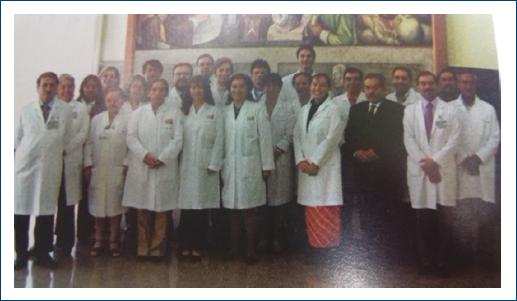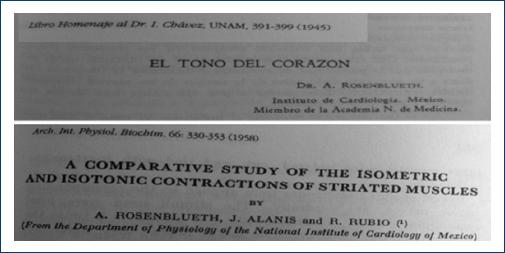The department of physiology was established in 1947 by Dr. Arturo Rosenblueth, in accordance with the ideas of Dr. Ignacio Chávez Sánchez, the founder of the Instituto Nacional de Cardiología. It was settled in the Manuel Suárez Pavilion of Physiology and Pharmacology, in the recently created Instituto Nacional de Cardiología (1944) whose old building was situated in the Colonia Doctores. The Instituto Nacional de Cardiología celebrates this year its 75th anniversary.
The newly created department counted in its early years with such distinguished researchers within the field of physiology as doctors: José Joaquín Remolina, Juan García Ramos, Ramón Alvarez-Buylla, Ricardo Miledi, Rafael Rubio, Juan Mandoki, Pablo Rudomín, Daisy Benítez, Hugo González Serratos, Jorge Pisanty, Eduardo Migliaro, Rafael Méndez, José Ramírez de Arellano, Jesús Alanís, Guillermo Pilar, Joaquín V Luco, among others1 (Fig. 1).

Figure 1 Members of the Department of Physiology of the Instituto Nacional de Cardiología around 1948.
The Department of Physiology of the National Institute of Cardiology of that time played a very important role in the development of physiology in Mexico. In fact, it can be considered, together with the Biomedical Research Institute and the Faculty of Medicine of the UNAM, as the cradle of physiology in Mexico. Out of the 19 founding members of the Mexican Society of Physiology, 8 belonged to the Instituto Nacional de Cardiología and 6 of them to its physiology department.
Dr. Rosenblueth studied, during his years in the department, the physiology of both skeletal and cardiac-striated muscle2,3 (Fig. 2). In addition, with great effort, he created the internal library of the department, which is currently part of the general institutional librarys collection and he helped in the design of many of the Grass equipment that have formed part of the laboratories of physiology throughout the world.
The department of physiology also had important visitors which collaborated with Dr Rosenblueth (Fig. 3) such as Rosenblueth and Cannon4 who created the concept of homeostasis, Wiener and Rosenblueth5 father of cybernetics, and Matthew N Levy who described the regulation of coronary circulation by adenosine among many. Dr. Rosenblueth, along with part of the researchers of the department of physiology, left the Instituto Nacional de Cardiología to found the Center for Research and Advanced Studies (CINVESTAV) of the National Polytechnic Institute in 1961.

Figure 3 Papers of Dr. Rosenblueth as collaborator of important visitors to the physiology department.
When Dr. Rosenblueth left the institute, Dr. Jesús Alanís became head of the department. He led it from 1961 to 1970. His studies focused on the electrophysiology of the nodes and conduction tissue (His bundle) as well as the regulation of the activity of the autonomic nervous system by carotid stimulation and the central nervous system6. He was the first to register the electrical activity of the bundle of His. Some of the researchers who stayed with Dr. Alanis when Dr. Rosenblueth left for CINVESTAV were Dr. Daisy Benítez, Dr. Rafael Rubio, Dr. Dieter Mascher, Dr. Julio Miyamoto, Dr. Gregory Skromne, and Dr. David Skromne.
When Dr. Alanis left the department to contribute to the University of Connecticut, Dr. Emilio Kabela took over as head of the department, and with him as head of the department, begins the years of the department in the new facilities in the fourth floor of the research building in Tlalpan. Dr. Kabela directed the department from 1970 to 1986. He made important advances in the study of the biophysics of ion exchange channels and pumps in different tissues of the heart and their participation in the electrophysiology of some heart diseases such as arrhythmias7,8. In addition, he participated in a very important way, in the development of biotechnologies within the institute, such as the production of cardiac valve prostheses and extracorporeal circulation machines. In fact, the Valves department now situated in the basement of the main building of the actual facilities of the Instituto Nacional de Cardiología emerged from the department of physiology and began its functioning in the area pertaining to the physiology department in the seventh floor of the research building.
When Dr. Kabela undertook the post of Research Subdirector of the institute in 1986, Dr. Fermín Valenzuela Gómez Gallardo took charge of the department. He directed the department until 1995 when he left to become the Head of the Pharmacology Department of the Faculty of Medicine of the UNAM. Dr. Valenzuela worked on the biophysics of ion channels related to membrane receptors and on the participation of histaminergic receptors in the physiology of vascular smooth muscle. He collaborated with Dr. Vasalle and Dr. Isenberg from New York9-11. During his period as head of the department, the Valves department became independent from the physiology department. During this time, the cellular biology section of this department which was in charge of Dr. Luis Felipe Montaño Estrada was created (1993), and it was established in the seventh floor of the research building, where the production of valve prostheses had been taking place. This section focused its studies on the biology of the endothelial cell and its role in cardiovascular pathology12.
After the exit of Dr. Valenzuela from the department, Dr. Rafael Mejía Álvarez became the head of the department for approximately 2½ years, before leaving the institute to continue his research at the University of Loyola, in Chicago, United States. His studies, while he was head of the department, focused on calcium channel biophysics during ontogeny13.
From the middle of 1997 to 2010, Dr. Verónica Guarner Lans took into her charge of the department. During this stage, the research lines in the department were diversified in an important way, being under the responsibility of new researchers14 (Fig. 4). The following topics were addressed:

Figure 4 Researchers and technicians during the period when Dr. Verónica Guarner was the head of the department of physiology (1996-2010). Image taken from Guarner, 200814.Front line from left to right: Felipe Massó, Bertha Soto (technician), Elvira Varela, Emma Rodríguez, Claudia Huesca, Rebeca López Marure, Luis Beltrán (technician), Gilberto Vargas, Florencio Hernández Lizardi (technician).Back, left to right: Araceli Páez, Ana María Sánchez (Secretary), María Esther Rubio Ruiz, Estrella Zapata, Oscar Pérez Méndez, Martín Martínez Rosas, Vicente Castrejón, Verónica Guarner Lans, Álvaro Vargas González, Roxana Carbó, Agustina Cano Martínez, José Manuel Rodríguez, Guillermo Flores (technician), Ricardo Gamboa, Mario Pérez (technician).Left to form the department of molecular Biology in 2008: Gilberto Vargas (Head of the Department (2008-2010), Oscar Pérez (head of the department since 2010), José Manuel Rodríguez.Left to form part of the translational medicine unit in 2017: Felipe Massó (Head of the Unit), Araceli Páez, Elvira Varela, Emma Rodríguez.
Effects of insulin and glucose and their possible mediators in vascular smooth muscle and heart and their association with hypertension and metabolic syndrome and/or type 2 diabetes. Responsible researcher: Dr. Verónica Guarner15.
Physiological factors of the regulation of high-density lipoprotein metabolism and its relationship with the incidence of atherosclerosis. Responsible researcher: Dr. Oscar Pérez Méndez16.
Polymorphism of genes in mestizo and indigenous populations of Mexico and their relationship with diseases. Responsible researcher: Dr. Gilberto Vargas Alarcón17.
Regeneration of the heart. Responsible researcher: Dr. Agustina Cano Martínez18.
Heterologous expression and functional characterization of channels and ion currents in cellular systems. Responsible researcher: Dr. Martín Martínez Rosas19
Biology of the endothelial cell in the formation of atheromatous plaques. Responsible researcher: Dr. Felipe Massó Rojas12.
Transduction of signals in factors that inhibit cell proliferation in endothelial cells and their alterations in the development of atherosclerosis. Responsible researcher: Dr. Rebeca López Marure20.
This policy of establishing different lines of study in the department led to the later formation of new research groups within the National Institute of Cardiology.
During this stage of the department, the mechanical and electrical workshop of the physiology department was in charge of technician Florencio Hernández Lizardi who helped in the manufacturing of different supplies for the researchers within the physiology department and researchers from other areas in the institute, continuing the tradition of the department in the development of research equipment.
Two researchers from the laboratories within the department of physiology, Dr. Gilberto Vargas Alarcón and Dr. Oscar Pérez Méndez, formed the new proteomics and genomics group of the institute in 2006, which later gave birth to the molecular biology department in 2008 in the new Anexo de Investigación. Some students also left with them including José Manuel Rodriguez, José Manuel Fragoso, Nonanzit Pérez, and Elizabeth Carreón.
Dr. Felipe Massó Rojas became the Head of the Department since the middle of 2010 and until 2017. In addition to the study of endothelial cells which he had been doing as part of the cellular biology section of the department, he became interested in the role of stem cells in the repair of myocardial damage21. Dr. Massó left the department by the end of 2017 to become the researcher in charge of the translational medicine unit, which was founded in collaboration with the Faculty of Medicine and the Biomedical Research Institute from UNAM. He left the department together with his group of researchers which included MS Araceli Páez, Dr. Emma Rodríguez Maldonado, MS Elvira Varela, and MS Blanca Ibarra.
The current head of the department is Dr. Rebeca López Marure. The department is currently formed by ten researchers, each with an independent field of research (Fig. 5). Dr. Rebeca López Marure studies the effects of dehydroepiandrosterone in cardiovascular diseases and cancer22. Dr. Verónica Guarner Lans studies early programming of hypertension and aging in metabolic syndrome and hypertension and the effects of aging23,24. Dr. Agustina Cano Martínez studies stem cells and cardiac regeneration25. Dr. Guadalupe Hernández Pacheco studies polymorphisms and cardiovascular autonomic regulation26. Dr. María Esther Rubio Ruiz studies role tiazolidinediones and fenofibrate in metabolic syndrome and cardiovascular diseases27. Dr. Martín Martínez Rosas studies ion channel participation in cardiovascular diseases28. Dr. Vicente Castrejón Téllez is interested in protein kinase C-dependent signaling in cardiovascular diseases29. Dr. Ricardo Gamboa Ávila and Dr. Claudia Huesca Gómez study the role of polymorphisms and microRNAs in cardiovascular diseases,30 and biologist Alvaro Vargas González is interested in the study of the proliferation of mammalian cardiomyocytes and the role of the autonomic nervous system and hypercaloric diets on cardiovascular disease31. The ratio of publications/researchers in the last 5 years of the researchers forming part of the department is of 1.7 papers per researcher per year.

Figure 5 Actual members of the Department of Physiology of the Instituto Nacional de Cardiología (2019). Technicians and secretary from left to right: Mario Miranda, Jhony Pérez, Mario Perez, Ana María Sánchez, and Guillermo Flores.
In conclusion, the department of physiology has played an important role in the development of physiology in Mexico since its beginnings. It participated in the formation of the Sociedad Mexicana de Ciencias Fisiológicas. It was the origin of an important national research centers (CINVESTAV) and has given rise to numerous groups and departments within the National Institute of Cardiology such as the Valves department, the department of molecular biology, and a laboratory in the translational medicine unit (Fig. 6). When new groups and departments were formed, the researchers left taking with them their job posts and their laboratory equipment. Therefore, the department has had periods of very high productivity and transcendence and less productive eras, especially after the separation of large groups of researchers to create new laboratories (When Dr. Rosenblueth left, when Dr. Kabela left, and when the Anexo de Investigación was created). The physiology department has importantly contributed to the development of research in the Instituto Nacional de Cardiología.











 nueva página del texto (beta)
nueva página del texto (beta)




